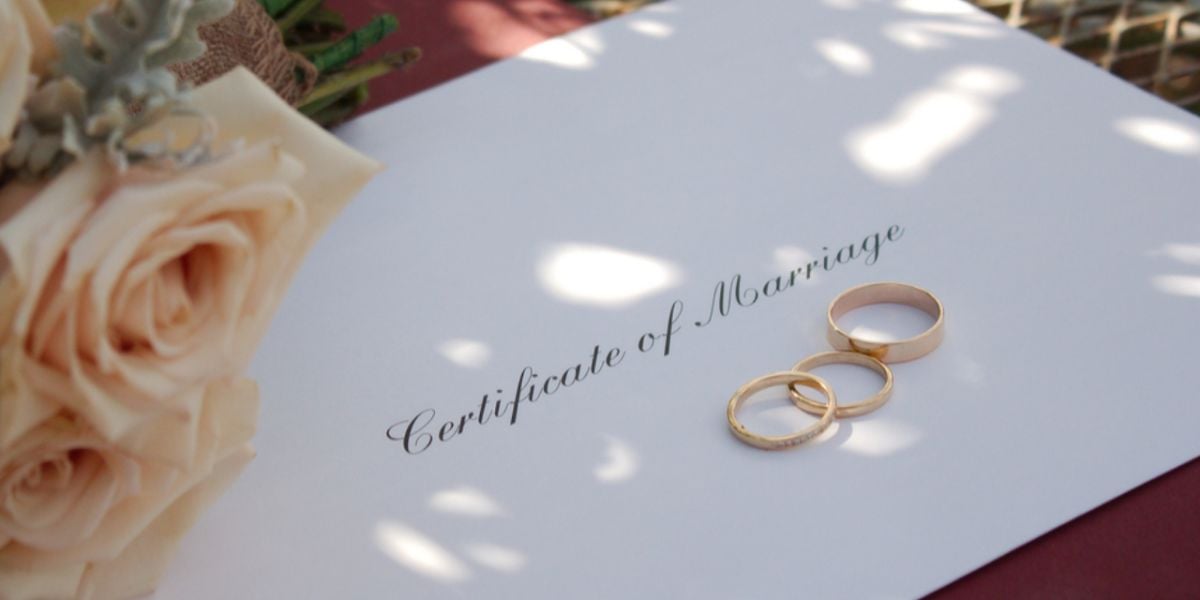
Australia is a beautiful place to get married. It's an excellent excuse for a destination wedding with friends and family, and you have a range of stunning and diverse wedding venues to choose from. But whether you're traveling Down Under to say 'I do' on one of Australia's beautiful beaches or tying the knot after already becoming an Australian resident or citizen, there are some unique aspects to the marriage process in Australia that are good to be aware of.
Marriage in Australia: the basics
Marriage in Australia is a legally recognized contract, and after the Marriage Amendment in 2017, the right to marry in Australia is no longer determined by sex or gender. You also don't have to be an Australian citizen or permanent resident of Australia to legally marry in Australia. However, if you are looking to remain in Australia after your marriage, you will need to plan for this in advance and secure the appropriate visa to be able to stay in the country.
To get legally married in Australia, there are some basic requirements, which are similar to those in other parts of the world. For instance, you must not be married to someone else or be marrying a parent, grandparent, child, grandchild, brother, or sister. You must also be at least 18 years old, unless a court has approved otherwise. Additionally, you must understand what marriage entails and consent to getting married.
A celebrant is someone who is legally recognized to authorize a marriage in Australia. After selecting a celebrant, you must complete a Notice of Intended Marriage form, which must be done at least one month before the wedding date, but can be up to 18 months beforehand. If there is less than one month until the wedding, contact your celebrant to discuss your options. In addition to this form, both parties will also need to provide your celebrant with:
- Proof of identity (passport or driver's license);
- Evidence of date and place of birth (birth certificate or passport);
- Proof that any previous marriages have ended.
You may also be required to complete a statutory declaration document to provide further information about your background and situation.
On the day of the marriage, you will sign three marriage certificates, which will be witnessed by your celebrant and two witnesses (who must be over 18 years of age). You will keep one of the marriage certificates, and your celebrant will lodge the rest of your marriage paperwork with the Registry of Births, Deaths and Marriages in the state in which your ceremony took place within 14 days.
Once all that's taken care of, you can head off on your honeymoon to whichever beautiful part of Australia you've chosen to visit.
Marriage-related paperwork and certificates in Australia
As marriage is a binding legal act in Australia, a number of important documents are involved:
- Notice of Intended Marriage. As mentioned above, couples intending to get married must submit this form at least one month before their wedding date. It includes information such as their full names, dates of birth, and places of birth, as well as details about any previous marriages or divorces. More information and online versions of the form are available here.
- Proof of identity: You will need to provide proof of your identity, such as a passport or driver's license. You don't need to be an Australian citizen or resident to get married in Australia, so you do not need to show your visa.
- Divorce or death certificate (if applicable): If you or your partner has been married before, you will need to provide a copy of the divorce certificate or death certificate of the previous spouse.
- Declaration of No Legal Impediment : This is a form that you and your partner will need to sign before the wedding, stating that you are unaware of any legal reasons that might prevent you from getting married in Australia.
- Marriage Certificate: After the wedding ceremony, you will be given a marriage certificate by the celebrant or officiating person, which is a legal document that confirms your marriage. If you need copies of this document down the line, they can be applied for via the Births, Deaths and Marriages department of the state or territory you got married in.
Be aware that the exact requirements for paperwork may vary depending on the state or territory where your ceremony is held. It's always a good idea to check with the relevant registry office or a marriage celebrant to confirm the specific requirements in your area.
Selecting a celebrant in Australia
To get married in Australia, you must have an authorized marriage celebrant officiate your ceremony.
There are four types of authorized marriage celebrants in Australia:
- Commonwealth-registered marriage celebrants: These celebrants are known as civil celebrants and are regulated by the government. They typically perform non-religious, civil ceremonies. You can find a Commonwealth-registered marriage celebrant by searching this database.
- Commonwealth-registered religious marriage celebrants: Religious celebrants are also regulated by the government, but are allowed to perform ceremonies that align with their religious beliefs. However, they must identify as a religious marriage celebrant when advertising their services. You can search for a Commonwealth-registered religious marriage celebrant here.
- Ministers of religion: This type of celebrant is managed by the Registry of Births, Deaths and Marriages in their state or territory or their religious organization. To qualify, the minister must be affiliated with a recognized religion in Australia. A list of recognized religions in Australia can be found here.
- State and territory officers: These officers are also regulated by the Registry of Births, Deaths, and Marriages in their respective state or territory and typically perform non-religious civil ceremonies. A celebrant of this kind can be found here.
Registry office or courthouse weddings in Australia
If you are not interested in having an elaborate ceremony at a private venue with all the bells and whistles, you may be interested in getting married at a registry office. There are no courthouse weddings in Australia, where you rock up to a court of law and say, 'I do.' There are registry office weddings, which are conducted by a government-appointed official in designated venues around the country. Registry office weddings are generally non-religious, civil ceremonies that are quick, simple, and affordable. Essentially, this type of wedding is less customizable than a private wedding. Still, you can choose from different wedding packages that allow you to add music and personalize your ceremony by including personal vows and readings. For example, Births, Deaths and Marriages Victoria offers a 30-minute, weekday Classic Wedding Package for AUD 480 (USD 312) or a 15-minute Legal-Only Package, from Monday to Thursday, for AUD 380 (USD 247).
If you want to get married at a registry office in Australia, everything can be booked and the paperwork submitted online. This type of marriage ceremony follows the same requirements as any other wedding — you will need to complete a Notice of Intended Marriage form and submit it to the registry office. This form can be lodged online from within Australia or from overseas. However, if you are lodging online from Australia, it must be witnessed by a Justice of the Peace, a Police Officer, a Doctor, a Lawyer, or a Notary Public if lodging from a different country.
You will also need to provide identification documents. A passport is the preferred method of identification; otherwise, you can use a Birth Certificate and sufficient photo ID. If either of you has been married previously, you will also need to supply a divorce certificate.
Once the Notice of Intended Marriage form has been lodged, the registry office can order your Commonwealth Marriage Certificate, and you can select a date for your ceremony. The cost of a registry office wedding in Australia varies depending on the state or territory in which you're located, but it is generally an affordable option for couples who want a simple and non-religious wedding ceremony.
Marriage equality in Australia
In December 2017, the Australian parliament passed a historic law legalizing same-sex marriage. Before the law was introduced to parliament, a voluntary postal survey was conducted to assess public opinion on the issue. The result was that 61.6% of Australians supported the legalization of same-sex marriage. This spurred the introduction of a bill into the Australian Parliament, which would ultimately amend the Marriage Act to allow same-sex marriage.
The bill passed with overwhelming support, and on December 9, 2017, it received royal assent, officially making Australia the 26th country in the world to legalize same-sex marriage. Since then, same-sex couples have been able to marry in Australia and enjoy the same legal rights and protections as opposite-sex couples. The law also allows for the recognition of same-sex marriages conducted overseas.
Recognition of overseas marriage in Australia
If you have been married overseas, the marriage will be recognized by the Australian government as long as the marriage was considered valid by the country in which it occurred and would have been identified as valid under Australian law.
Important:
An overseas marriage cannot be registered in Australia (registration is different from recognition), but the foreign marriage certificate can be used as evidence that the marriage occurred. Ensure you keep hold of the certificate from an overseas marriage, as it is often the only evidence that a marriage has occurred. Be aware that an overseas marriage certificate may also not be valid for some purposes in Australia, so consult the Smartraveller website for more details.
De facto marriage in Australia
A ‘de facto marriage' is also recognized in Australia and is defined in Section 4AA of the Family Law Act 1975 as you and your partner (either same-sex or opposite sex) having a relationship as a couple living together on a genuine domestic basis. Under Australian law, de facto couples are entitled to many of the same legal rights and protections as married couples, including property and financial arrangements, superannuation entitlements, and access to family law courts in the event of a separation. However, the legal rights and protections afforded to de facto couples vary depending on the state or territory in which they live, as family law is governed by state and territory legislation in Australia.
In some states and territories, a de facto relationship is automatically recognized after a specified period, whereas in others, couples may need to register their relationship to access certain legal rights and entitlements. It's important to note that while de facto relationships are legally recognized in Australia, there are still some legal differences between de facto and married couples. For example, de facto couples may not have the same automatic rights to property and assets in the event of a separation and may need to prove their contributions to the relationship to receive a fair settlement.
Divorce in Australia
You can apply for a divorce in Australia if either you or your spouse regards Australia as home and intends to live in Australia indefinitely, are an Australian citizen by birth or by the grant of Australian citizenship, and have lived in Australia for 12 months immediately before filing for the divorce. You must confirm that you and your spouse have lived separately for at least 12 months and there is no likelihood of resuming married life.
In Australia, divorce is granted on a ‘no-fault' basis, meaning that a couple does not have to prove that one spouse is at fault for the breakdown of the marriage. This is in contrast to other countries where fault-based divorce is the norm. To apply for a divorce, you must complete an online interactive application and pay the fee of AUD 1,100 (USD 716). Or you may be eligible for a reduced cost of AUD 365 (USD 237) if you are experiencing financial hardship, you have been granted legal aid, or you are the primary holder of a healthcare card, pensioner concession card, or senior's card. You are eligible for a healthcare card if you are a permanent resident, or you are on a Special Category Visa, a Partner Provisional or Temporary Protection Type Visa. Check the Federal Circuit and Family Court of Australia for more information.
We do our best to provide accurate and up to date information. However, if you have noticed any inaccuracies in this article, please let us know in the comments section below.








